Why Today's Saran Wrap Is Less Sticky
Ever wondered why Saran Wrap is dissimilar today than it used to be? Turns out, there's a pretty good reason why the kitchen staple lost some of its stick.
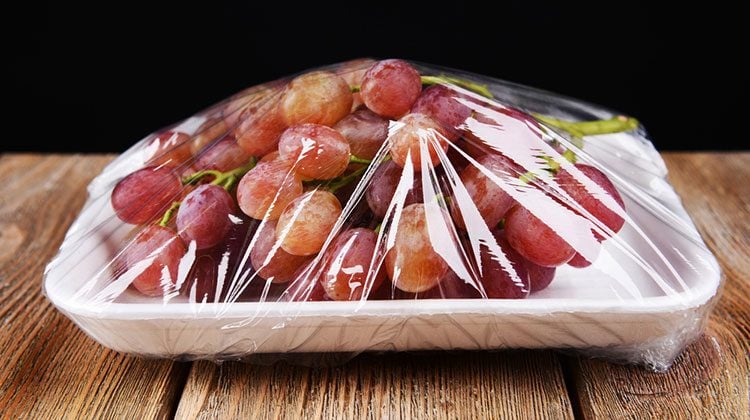
In 1953, Saran Wrap appeared in stores equally the first and only material for storing nutrient that could keep food fresh, block odors and withstand extreme temperature changes. Information technology was too an extremely glutinous motion picture, often green in color, that kitchens across America would come up to know and love. If you grew upwardly during that fourth dimension, you probably remember peeking at Christmas cookies veiled beneath a film of green plastic, veggie trays trapped in gauzy wrapping and leftovers mummified in clear casing. Just did you notice that the Saran Wrap we have today is not the same?
Is it really different?
Since 2004, Saran Wrap has been clear, far less sticky, and a piddling less effective—it can't withstand loftier heat levels or repel harsh smells—compared to the original product. People still purchase it, simply nosotros've heard grumbles. The new wrap just isn't every bit good as the quondam wrap. We had to wonder: Why bother making this alter in the first place?
The answer didn't go far until 2015, over 10 years later the Saran Wrap formula was updated. SC Johnson, the visitor that has endemic Saran Wrap since 1998, shared the story in a Harvard Business concern Review article. Once we heard the real story, we were immediately behind it. Spoiler alert: The Saran Wrap of today might be slightly less viscid, but information technology's a thousand times better for the planet. (Desire to relieve the planet at habitation? Effort these tips.)
Here'south why Saran lost (some of) its stick
CEO Fisk Johnson wrote that Saran Wrap'southward original formula independent polyvinylidene chloride (PVDC), which may have released toxic chemicals when consumers threw information technology in the trash and sent it to incinerators for disposal. On its own, the company decided to change the formula to remove the chemical-knowing that sales would suffer. "In one case nosotros learned about the possible toxic chemicals PVDC emitted from landfills, nosotros never really considered retaining the original formulation," Johnson told a local newspaper. "Doing the right matter for customers is always the correct matter for the states."
This wasn't the beginning time the company did something like that, either. In 2007, SC Johnson traded its Windex bottle for a version that weighed less, saving 1 million pounds of waste material per yr. In 2011, it switched Pledge to an droplets that worked with compressed air instead of chemicals, eliminating 6 million pounds of toxic compounds from the atmosphere annually. All these changes have sprouted from a 2001 hope to meliorate sustainability.
So what if today'south Saran Wrap isn't as viscid? Nosotros don't care. In fact, we recall information technology'southward pretty cool that SC Johnson decided to make a modify for the skillful of the planet. And the new formula works just fine for keeping our leftovers safe and fresh.
Got leftovers nether wraps at dwelling? Apply them up with these recipes.

Flossy Chicken Enchiladas
My daughter has the best cream cheese craven enchiladas recipe I've ever tried. She brought 10 pans of it to my hymeneals reception and they were the biggest hit of all the food. And then many guests wanted the recipe, we sent it out with our Christmas cards. —Pat Coffee, Kingston, Washington
Get Recipe

Chicken, Nectarine and Avocado Salad
This salad is really summery and comes together very speedily. Using granola adds crisis and makes it dissimilar. I've tried using a various types of granola, and our favorites have been those that aren't overly sweet but have lots of basics. —Elisabeth Larsen, Pleasant Grove, Utah
Cherry Chicken Croissants
I had a similar craven salad at a restaurant and created my own version. It may seem like an odd combination, but the ingredients work really well together. My children love it, and it only takes a few minutes to cutting everything upwardly—and so like shooting fish in a barrel!

Peanut Butter, Craven and Basil Sandwich
Stay with me, here. These classic Thai flavors work on so much more than than noodles...endeavor 'em on a sandwich and you won't exist disappointed. —James Schend, Taste of Home Deputy Editor

Spicy Chicken and Salary Mac
I've been working to perfect a creamy, spicy mac and cheese for years. Later on adding smoky bacon, chicken, jalapenos and spicy cheese, this is the ultimate! I use rotisserie chicken and precooked salary when I'm pressed for time. —Sarah Gilbert, Aloha, Oregon

Craven Cordon Bleu Stromboli
If craven cordon bleu and stromboli had a baby, this would be it. Serve with jarred or homemade Alfredo sauce, or classic Mornay sauce on the side if desired. —Cynthia Gerken, Naples, Florida
Deadening-Cooker Chicken Enchilada Stuffed Peppers
Use up leftovers and clean out the fridge by making these super simple and tasty blimp peppers! This is an ideal weekend meal that yous can put together rapidly and let cook while you run errands. —Katie Jasiewicz, Belle Isle, Florida
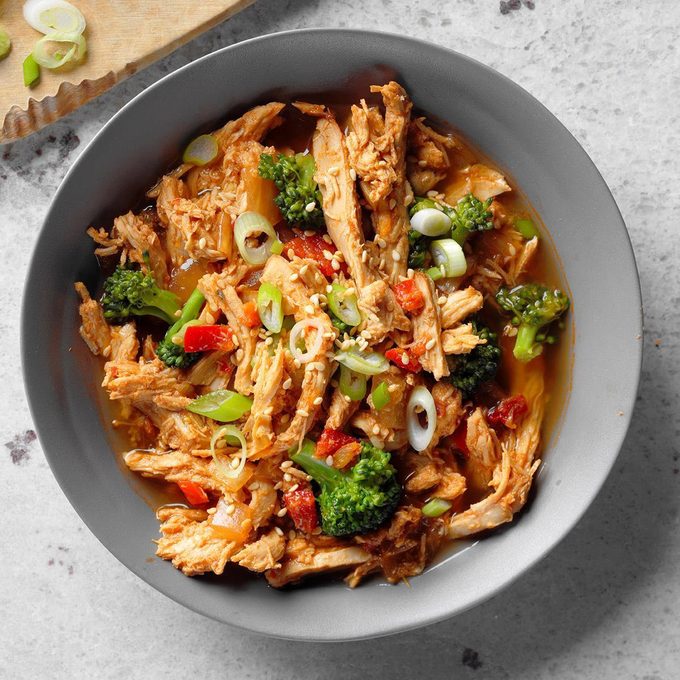
Full general Tso's Stew
I love Asian food and wanted a chili-like soup with the distinctive flavors of General Tso's chicken. The deadening cooker makes this super easy, and you can utilise any meat y'all similar. It's a great with turkey, ground meats or leftover pork. —Lori McLain, Denton, Texas
BBQ Chicken and Apple tree Bread Pudding
To me, bread pudding is the epitome of condolement food and is simply besides adept to reserve but for dessert. This sweet and savory twist on the archetype is a succulent new manner to relish an old favorite. —Shauna Havey, Roy, Utah
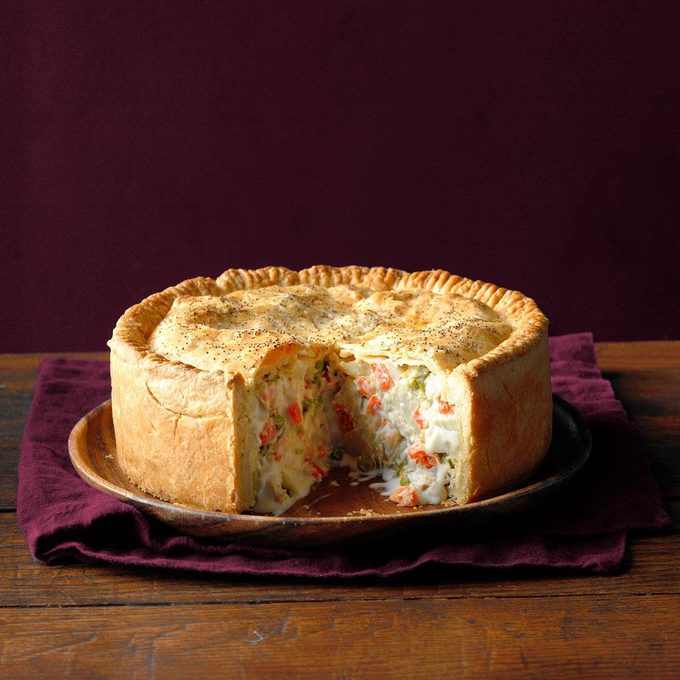
Mile-High Craven Potpie
Classic chicken potpie gets extra homey when information technology's loaded with a creamy filling and baked alpine in a springform pan. This deep-dish marvel is perfect for Sunday dinners. —Shannon Roum, Food Stylist, Taste of Home magazine
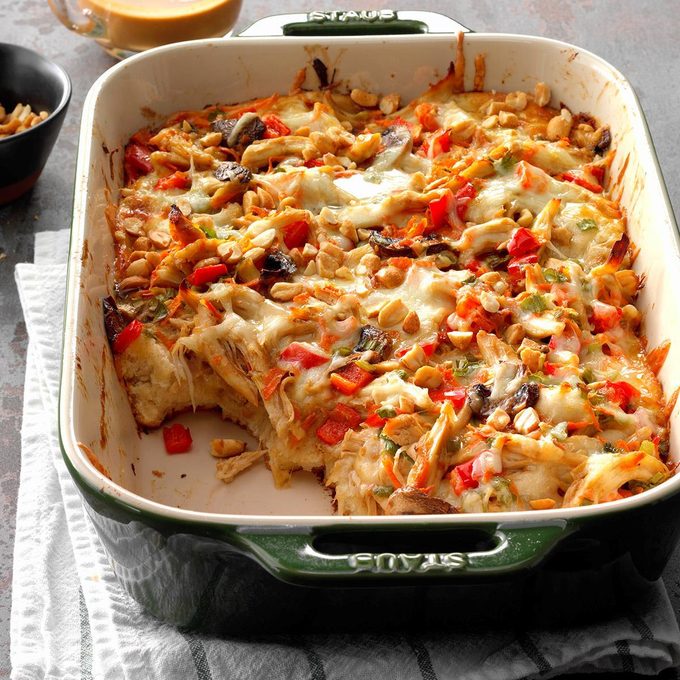
Thai Peanut Chicken Casserole
I used traditional pizza sauce and toppings in this recipe for years. After condign a fan of Thai peanut chicken pizza, I decided to employ those flavors instead. Serve with stir-fried vegetables or a salad with sesame dressing for an like shooting fish in a barrel, delicious meal. —Katherine Wollgast, Troy, Missouri
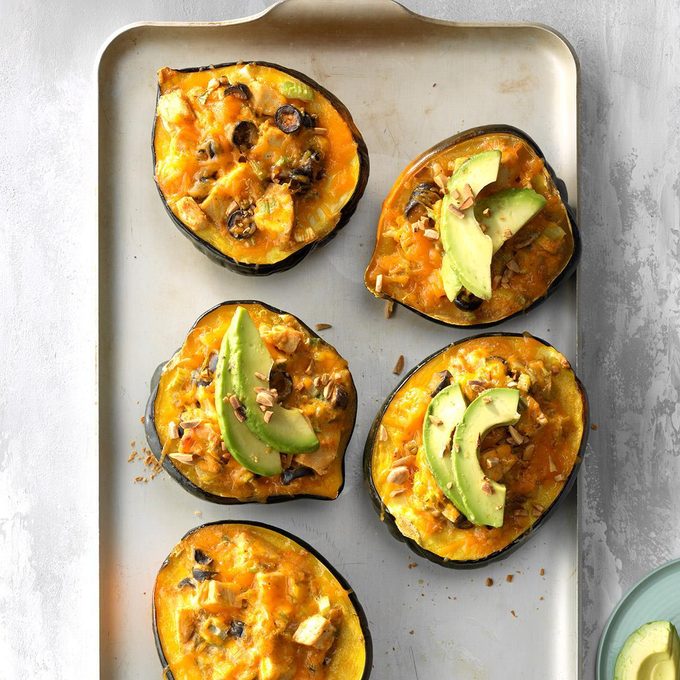
Arizona Chicken in Acorn Squash
Give stuffed acorn squash a taste of the Southwest with this comforting recipe. We love the crisis of the toasted almonds, heat of light-green chiles, and creamy texture of avocado. —Martha Sparlin, Albuquerque, New Mexico

Curried Chicken Skillet
This poly peptide-packed skillet dish is loaded with bright flavor. A fiddling back-scratch and fresh ginger brand the veggies, chicken and quinoa pop. —Ruth Hartunian-Alumbaugh, Willimantic, Connecticut
Slow-Cooker Green Chile Chicken Enchilada Pie
My married man likes some heat in our meals, but our children—not so much. This is the best of both worlds. Serve with additional chopped cilantro and a dollop of sour cream if desired. —Dana Beery, Ione, Washington
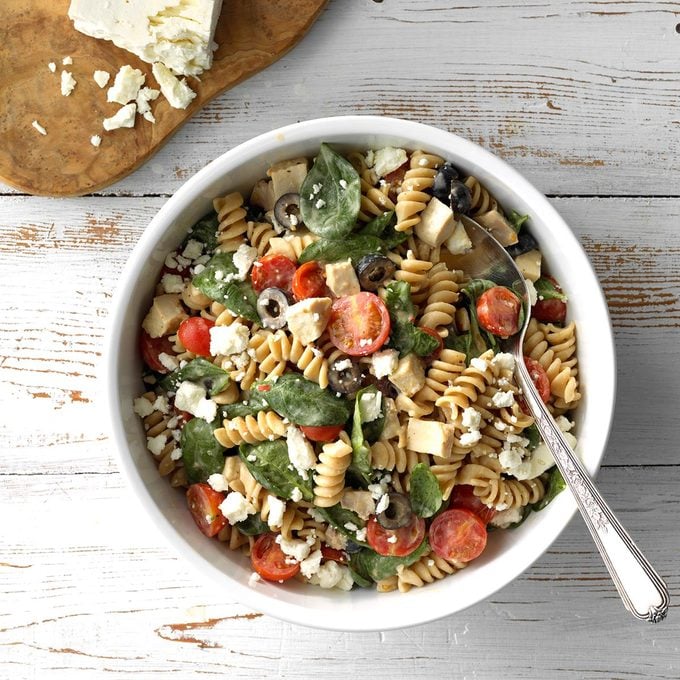
Chicken and Spinach Pasta Salad
My family loves pasta salads, merely usually they take also much mayonnaise or oily dressing. Using hummus gives this dish a great taste and texture, while likewise increasing its nutritional profile. Calculation chicken (store-bought rotisserie chicken works well), makes this pasta salad a complete meal. —Jenny Lynch, Stone Island, Illinois
Cobb Salad Wrap Sandwiches
These wraps are easy for a summertime nighttime—and, even better, I don't take to plow on my oven. At that place are smiles all around when I make this for dinner. —Bonnie Hawkins, Elkhorn, Wisconsin

Chicken Potpie Galette with Cheddar-Thyme Crust
This gorgeous galette takes traditional chicken potpie and gives it a fun open-faced spin. The rich filling and flaky cheddar-flecked chaff make it gustatory modality so homey. —Elisabeth Larsen, Pleasant Grove, Utah

Warm Chicken Tortellini Au Gratin
This is one of my favorite recipes. Pasta from Monday plus roasted chicken from Tuesday equals this delicious dish on Wednesday. It's fast and succulent, and paired with a green salad and toasty bread, you accept a meal that'south fancy enough for company. —Brenda Cole, Reisterstown, Maryland
Muffin-Can Chicken Potpies
I made these personalized chicken pot pies in muffin tins for my kids, and they gobbled them upwards. For the record, the grown-ups did, too! —Melissa Haines, Valparaiso, Indiana
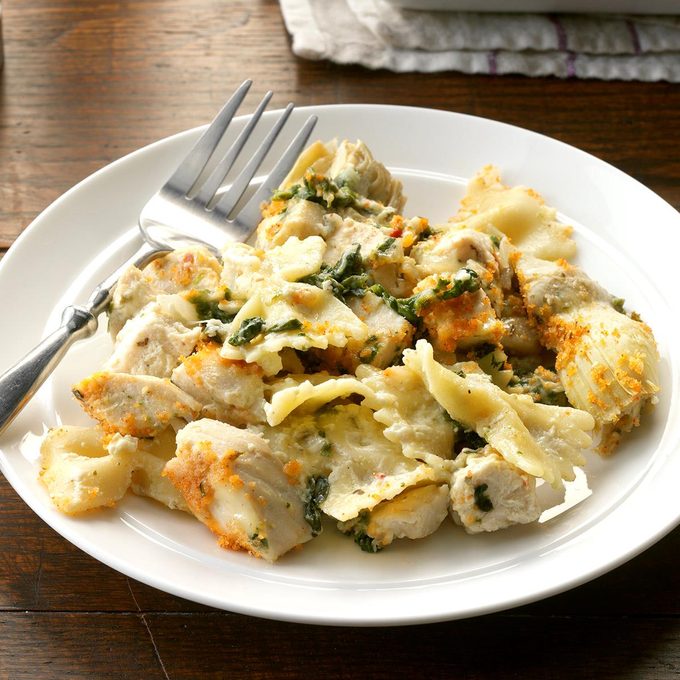
Artichoke & Spinach Chicken Goulash
Effort this homey and comforting goulash for an alternating primary dish at Thanksgiving. The spinach adds overnice colour, and the cherry pepper flakes add together a pleasant, mild heat. —Janice Christofferson, Eagle River, Wisconsin

Craven Florentine Pizza
On pizza night, we like to switch things up with this craven and spinach version. One gustation of the ricotta cheese base and you won't miss traditional sauce one scrap. —Phil Corder, Monroe, Louisiana
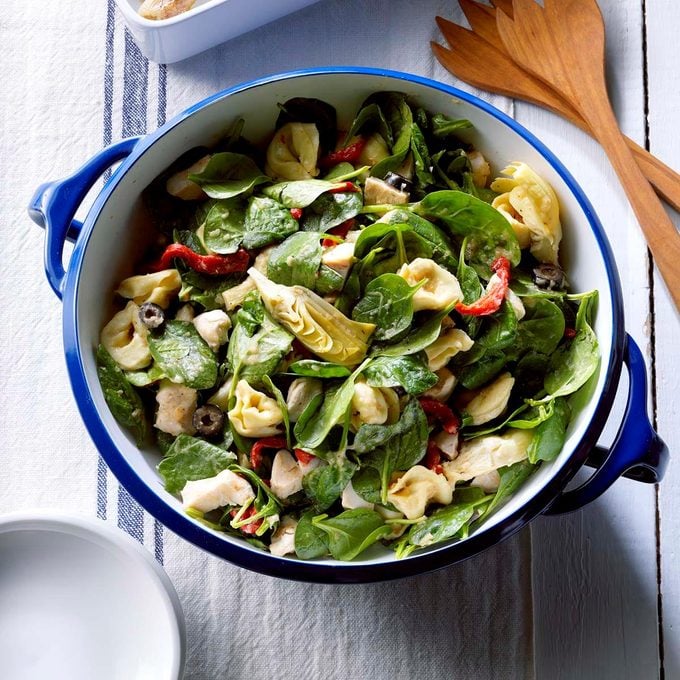
Spinach Salad with Tortellini & Roasted Onions
Spinach and tortellini get so well together, and this salad makes an easy meal with leftover cooked craven. What really makes it special is the roasted onion that adds oomph to bottled salad dressing. —Robin Haas, Hyde Park, Massachusetts
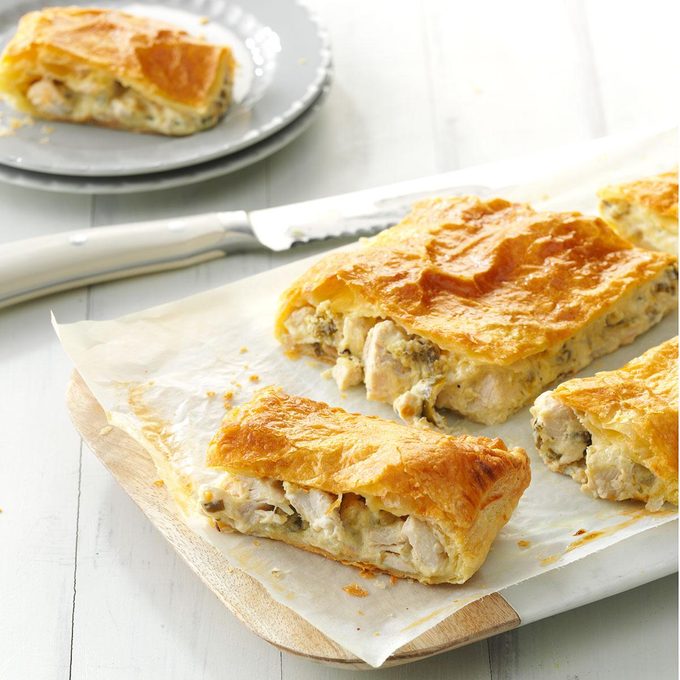
Jalapeno Popper Pocket
For a fresh take on fried jalapeno poppers, we stuff chicken, cheeses and jalapenos inside puff pastry, then bake it. —Sally Sibthorpe, Shelby Township, Michigan
Chicken & Cheddar Beige Casserole
I ever get rave reviews when I bring this casserole to my son's Cub Scouts meetings. Information technology's the perfect comfort meal after a long day. —Sarah Phillips, East Lansing, Michigan
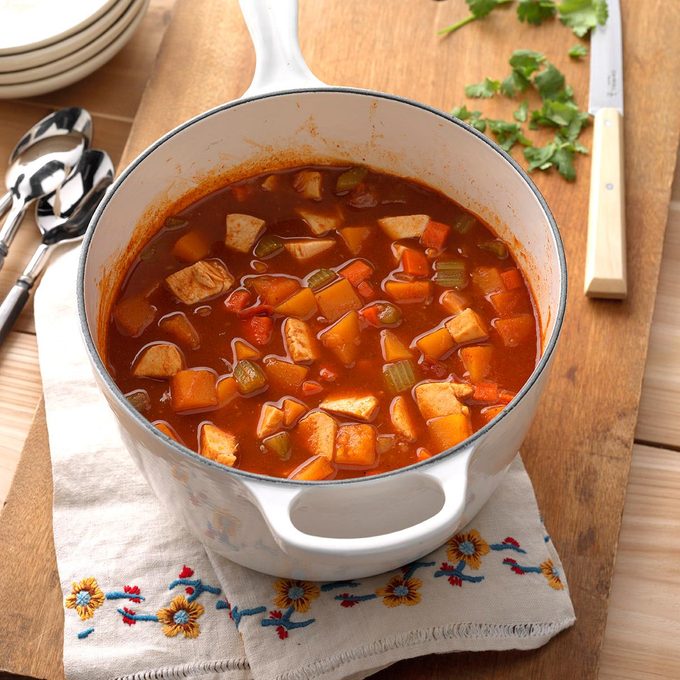
Chicken Butternut Chili
At our house, we just love a good comforting, hearty, love apple-based chili with bold flavors! This unique chili is loaded with veggies and flavor. You lot can besides gear up the recipe in the tedious cooker. Merely add ingredients to the crock and cook over loftier oestrus for about 4 hours. —Courtney Stultz, Weir, Kansas
Chicken Ranch Flatbreads
To become my son to try new things, I revamped this mini pizza. Mr. Picky ate it, so it's definitely family-friendly, even for those with fussy tastes. —Jenny Dubinsky, Inwood, West Virginia
Chicken Alfredo Lasagna
My family was growing tired of traditional cerise sauce lasagna, and so I created this fun twist using a creamy bootleg Alfredo sauce. Store-bought rotisserie chicken keeps prep simple and fast. —Caitlin MacNeilly, Uncasville, Connecticut
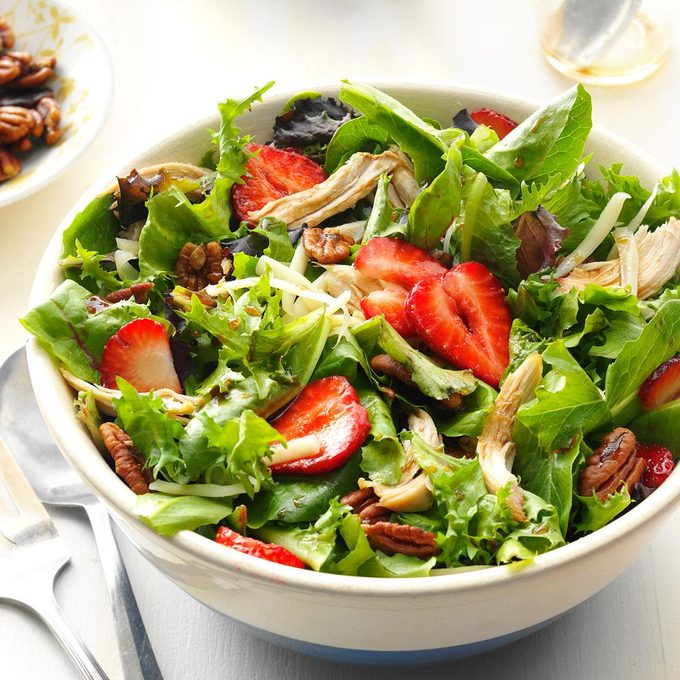
Strawberry-Craven Salad with Buttered Pecans
Having lived in several states in the Southward, I love tossing pecans into recipes for a picayune added flavor and crunch. Fresh berries and other nuts circular out this hearty salad. —Lisa Varner, El Paso, Texas
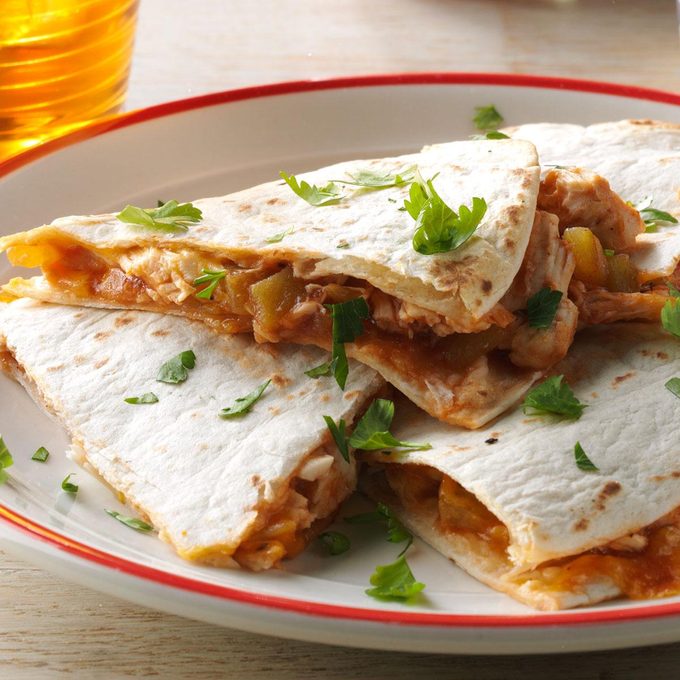
Barbecue Chicken Quesadillas
When my kids were pocket-sized, I'd stuff leftover chicken into these oven-baked quesadillas. I oft take hold of rotisserie chicken instead. —Pam Martin, Canandaigua, New York
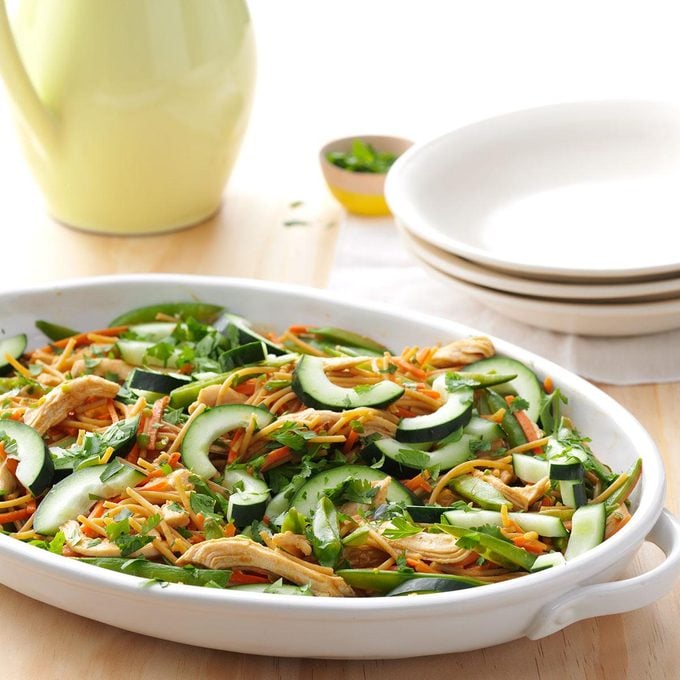
Thai Chicken Pasta Skillet
This gorgeous Bangkok-style pasta has been a true-blue standby for many years and e'er gets loads of praise. For a potluck, we increase it and do information technology ahead. —Susan X Pas, Myrtle Creek, Oregon
Bluish Cheese Chicken Salad Sandwiches
I'grand a big fan of bluish cheese dressing, so I decided to go the "no mayo" route and supplant it in this craven salad. So tangy! Serve the craven mixture on a bed of lettuce if you're in the mood for salad instead. —Giovanna Kranenberg, Cambridge, Minnesota

Dark-brown Rice Mulligatawny
My friends tell me this is one of the best soups they've always had. One even said information technology's "perfect." No 1 guesses that information technology'southward healthy!—Sarah Ott, Blanchardville, Wisconsin.

Raspberry Pecan Chicken Salad
I gave this sweet-savory chicken salad a little cipher with Chinese five-spice pulverization, which tastes a bit like pumpkin pie spice. Sprinkle some on roasted carrots for an awesome meal. —Lisa Renshaw, Kansas City, Missouri
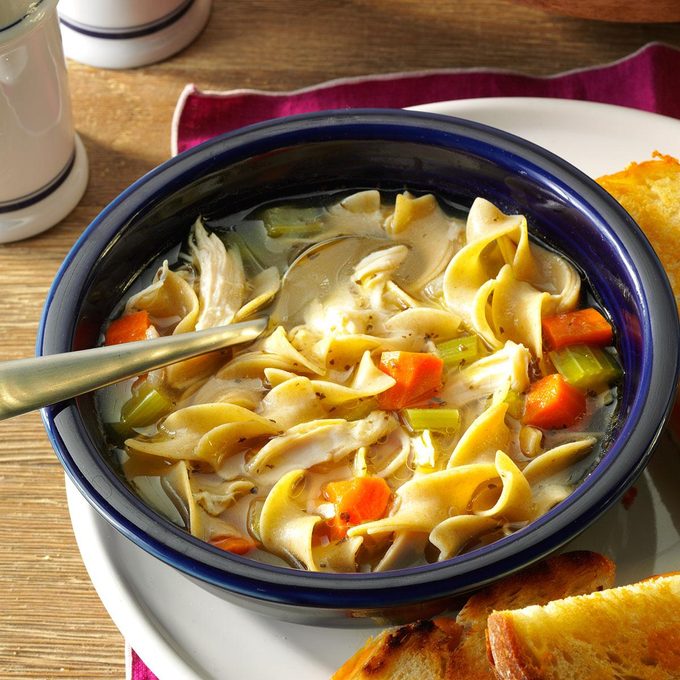
Cold-Day Chicken Noodle Soup
When I was sick, my mom would brand me this heartwarming craven noodle soup. It was soothing when I had a cold, just this soup is a bowlful of comfort on whatsoever chilly day. —Anthony Graham, Ottawa, lllinois
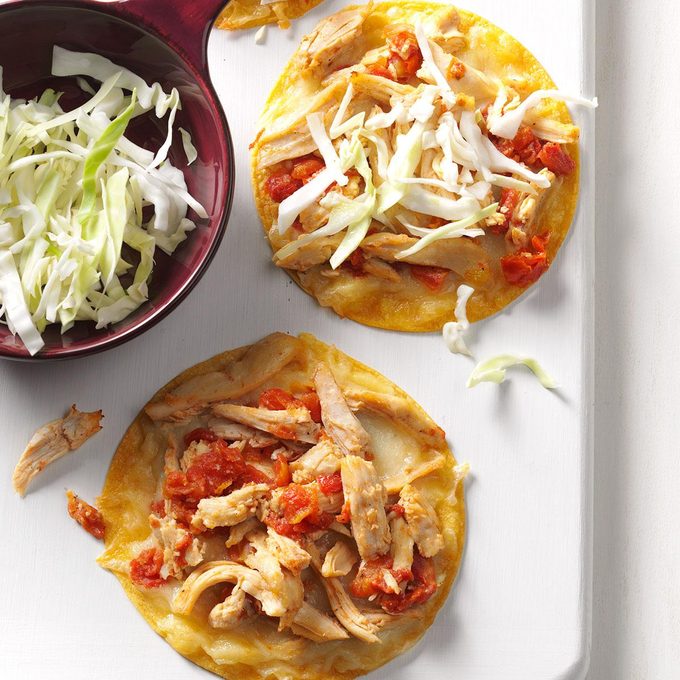
Baked Craven Chalupas
I wanted an piece of cake alternative to deep-fried chalupas, so I bake them with filling on superlative. —Magdalena Flores, Abilene, Texas

Quick Chicken & Broccoli Stir-Fry
This Asian craven and broccoli stir-fry is a household best bet. The spicy sauce works with chicken, seafood, pork or beefiness. Add whatever veggies you lot have on hand. —Kristin Rimkus, Snohomish, Washington
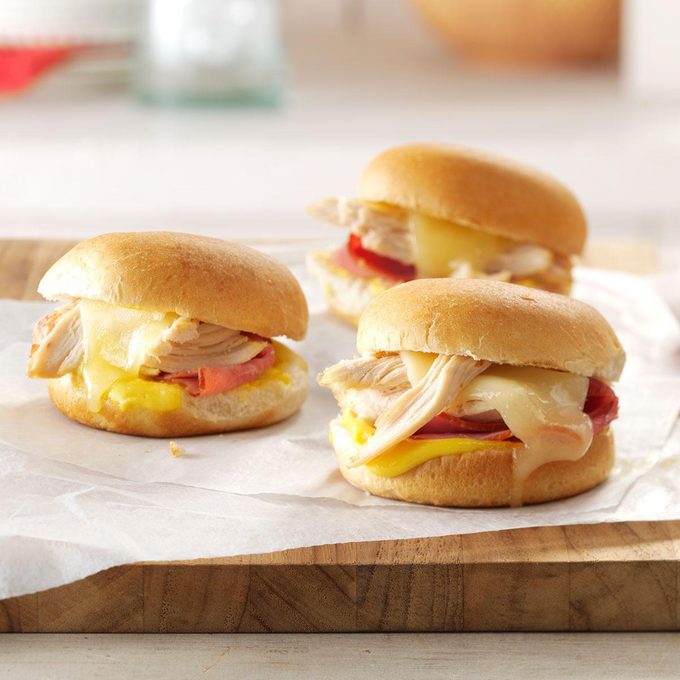
Swiss Chicken Sliders
Friends came over for a spur-of-the-moment bonfire, and I dreamed up these quick chicken sliders and so we'd accept something to consume. Bake them till the cheese is gooey. —Sara Martin, Whitefish, Montana
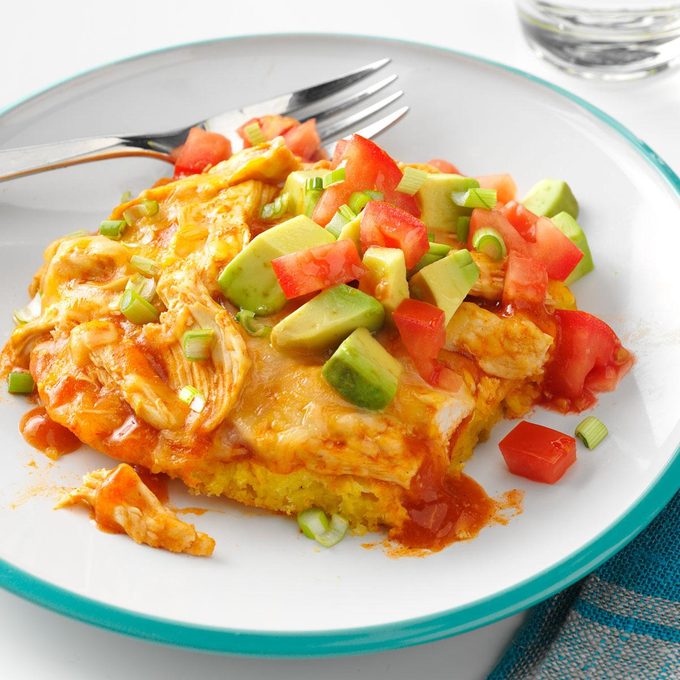
Chicken Tamale Broil
When I serve this Mexican-style casserole, everyone scrapes the plate clean. Offer fresh toppings like dark-green onions, tomatoes and avocado. —Jennifer Stowell, Smithville, Missouri

Chicken Ranch Mac & Cheese
Prep once and feed the family twice when y'all double this craven mac and cheese and freeze half of it. I created it for the people I love nearly, using ingredients they dear almost. —Angela Spengler, Tampa, Florida
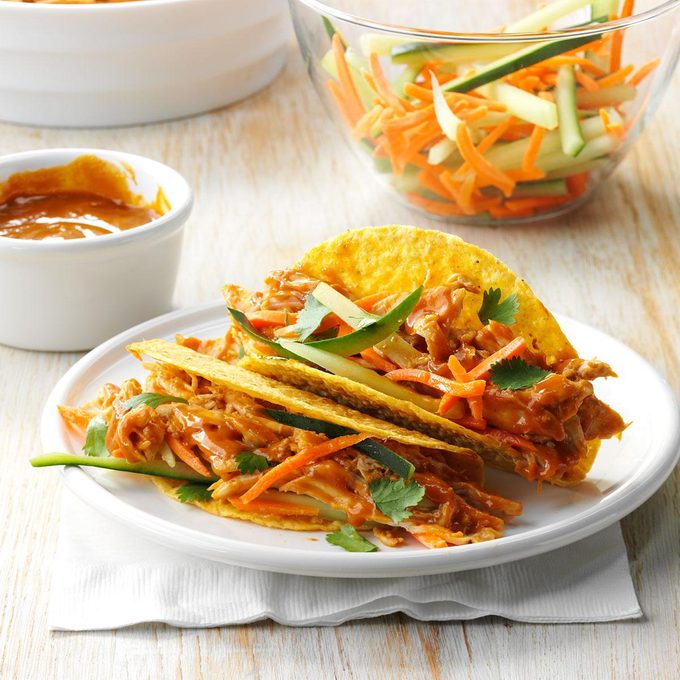
Thai Chicken Tacos
Inspired by a Vietnamese banh mi sandwich, this recipe is an awesome way to use leftover chicken. If y'all have a piddling extra fourth dimension, let the carrot and cucumber marinate in some rice vinegar before taco time. —Melissa Halonen, Spokane, Washington
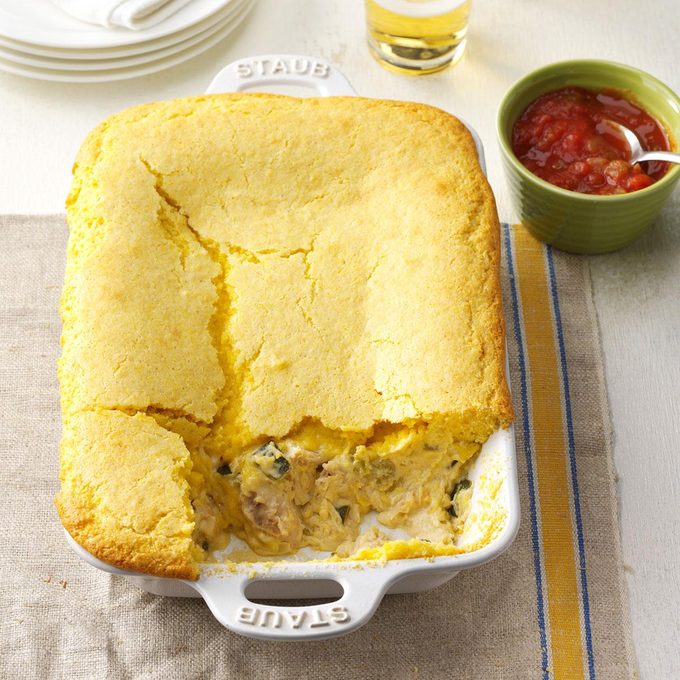
Chicken Chiles Rellenos Goulash
My hubby likes Mexican food and casseroles, so I combined the ii. This chicken with poblanos and chiles satisfies our craving for dinner at a Mexican eating house. —Erica Ingram, Lakewood, Ohio
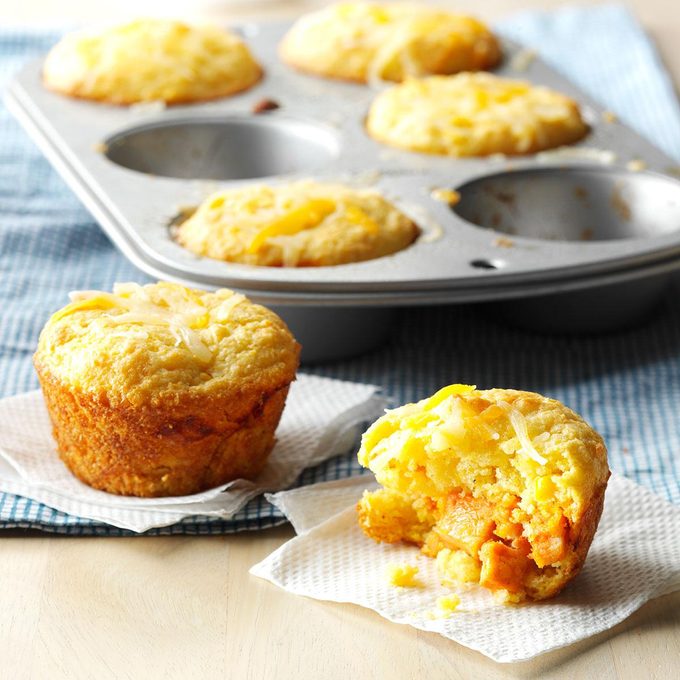
Muffin-Tin Tamale Cakes
We needed snack inspiration beyond peanut butter and jelly. These muffin tamales have all of the flavour without the fuss. Pair with skewered fruit. —Suzanne Clark, Phoenix, Arizona
Baked Nectarine Chicken Salad
Folks dear the crunchy grub mein noodles on top. I love that I can make it a day in accelerate and air-condition until it's fourth dimension to serve. Serve with hot bread or rolls. —Faye Robinson, Pensacola, Florida
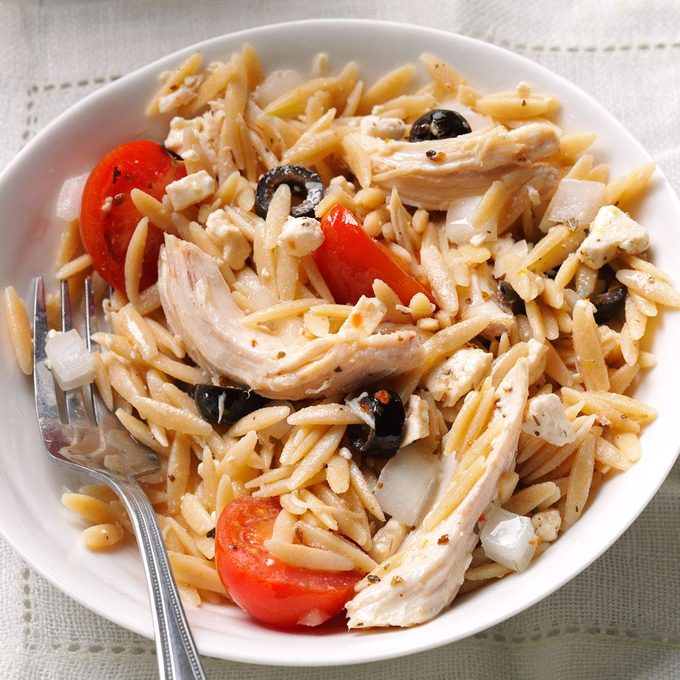
Mediterranean Orzo Chicken Salad
On hot days, I pull out this recipe for a cool supper. The lemon dressing is so refreshing. If you have it, used grilled chicken. —Susan Kieboam, Streetsboro, Ohio
Grilled Zucchini with Peanut Chicken
Zucchini slices make perfect finger food. It's fun to brand a topping for zucchini and a adept solution for a never-catastrophe crop. — Elisabeth Larsen, Pleasant Grv, Utah

Sausage & Chicken Gumbo
This recipe for classic southern comfort food was the starting time thing I always cooked for my girlfriend. Information technology was simple to make merely tasted gourmet—definitely dearest at starting time bite. —Kael Harvey, Brooklyn, NY
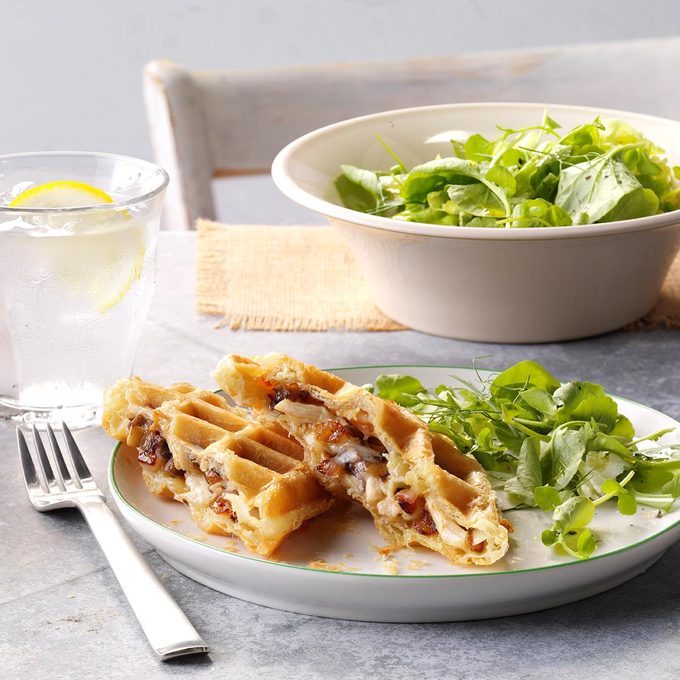
Cheesy Chicken Wafflewiches
I've had lots of fun experimenting with my new waffle maker. I decided to apply shredded meat, cheese and vegetables for a savory twist. Make sure the griddle is hot before calculation the sandwiches. —Marietta Slater, Justin, Texas

Craven & Blue Cheese Pizza
The blue cheese in place of the expected mozzarella gives this pizza a surprising and sophisticated taste. It'southward excellent as an entree or appetizer—it tin exist prepared in a round pizza pan as well. —Beverly Lynch, Sugar Grove, Illinois
Spicy Peanut Craven Chili
While spending time in the Southwest, I discovered Mexican peanut chicken and thought it would be fun to make it into a chili. Chipotle peppers give it a nice spice that's extra warming on a cold day. —Crystal Schlueter, Northglenn, CO

Hot Brown Turkey Casserole
If you've always tried the Hot Dark-brown Sandwich at the Brown Hotel in Louisville, Kentucky, you'll love this version. It tin can exist assembled ahead and refrigerated; just adjust blistering time accordingly if cold. —Diane Halferty, Corpus Christi, Texas

Asian Chicken Rice Bowl
This super flavorful, nutrient-packed dish makes use of supermarket conveniences like coleslaw mix and rotisserie chicken. This recipe is easily doubled or tripled for large families. —Christianna Gozzi, Asteria, New York
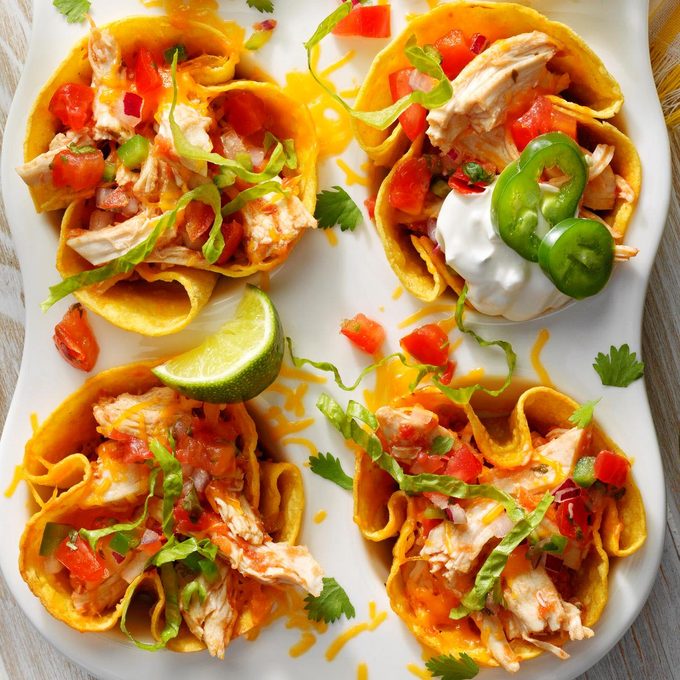
Craven Tostada Cups
Several years ago I tried a version of these cups at a eatery in Santa Fe, and I wanted to make my own spin. These are corking for gatherings where y'all can allow everyone add their ain favorite toppings. —Marla Clark, Moriarty, New Mexico
Barbecue Chicken Tostadas
Lots of my recipes (just like this one) start out as fun ways to utilize leftovers. My kids dear tostadas, and then this 24-hour interval-after-cookout dinner was a big hit. —Lauren Wyler, Dripping Springs, Texas

Buffalo Chicken Biscuits
These spicy, savory muffins are e'er a striking at parties. We love them equally a uncomplicated snack on game day, too. —Jasmin Baron, Livonia, New York

Spicy Peanut Chicken & Noodles
This simple spicy peanut noodles recipe tastes like it took hours to make. Everybody says information technology has the perfect levels of heat and spice. —Sharon Collison, Newark, Delaware
Craven & Swiss Goulash
It'southward squeamish to accept an alternative to the traditional broiled ham on Easter. This comforting goulash is always a crowd-pleaser. Using rotisserie craven from the deli makes prep simple. —Christina Petri, Alexandria, Minnesota
Skinny Cobb Salad
This "skinny" version of Cobb salad has all the taste and creaminess with one-half the fat and calories. You tin skip the coleslaw mix and do all lettuce, but I like the crunch you go with cabbage. —Taylor Kiser, Brandon, Florida
Loaded Chicken Carbonara Cups
Spaghetti cupcakes with a chicken carbonara twist brand for a tasty, fun family unit dinner. Whole wheat pasta and reduced-fat ingredients brand these quick and easy lilliputian pasta cakes nutritional winners, likewise. —Jeanne Holt, Mendota Heights, Minnesota
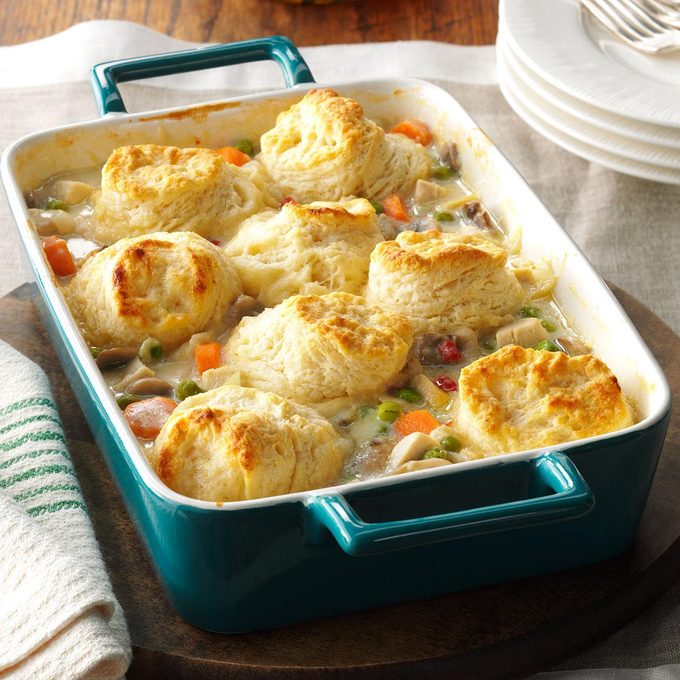
Chicken Potpie Goulash
I ever take leftover chicken broth on hand and use it for many things, including this comforting family unit favorite. You lot tin broil your own biscuits as I do or purchase them at the store. I like to bake extra biscuits to eat with butter and jam. —Liliane Jahnke, Cypress, Texas
Apple tree Craven Quesadillas
My sister came upward with an easy recipe that can be served equally a main course or an titbit. People are surprised by the combination of craven, apples, tomatoes and corn inside the crispy tortillas, but they dearest it. —Stacia Slagle of Maysville, Missouri

Buffalo Chicken Wing Soup
My hubby and I love buffalo chicken wings, so we created a soup with the aforementioned zippy flavor,. It'due south very pop with guests. Start with a small amount of hot sauce, and then add more if needed to accommodate your family unit'south tastes. —Pat Farmer, Falconer, New York
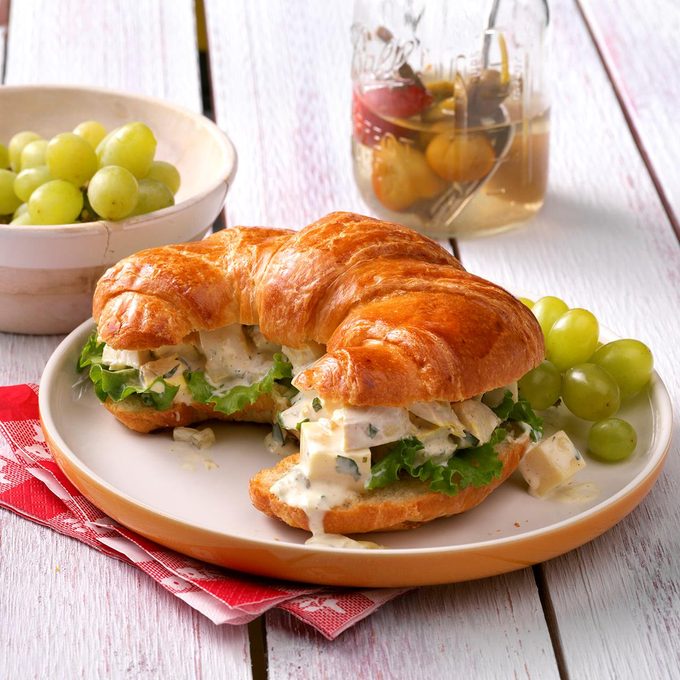
Chicken Salad Croissants
This tempting chicken salad that gets its special taste from Swiss cheese and pickle bask. It's a favorite of my brother, who insists I make it whenever he visits. —Laura Koziarski, Battle Creek, Michigan

Baked Egg Rolls
These egg rolls are low in fat but the crispiness from baking will fool y'all into thinking they were fried! —Barbara Lierman, Lyons, Nebraska
Spicy Chicken Lycopersicon esculentum Soup
Cumin, chili pulverisation and cayenne pepper requite my irksome-cooked specialty its kick. I serve bowls of it with crunchy tortilla strips that bake in no time. Leftover soup freezes well for nights I don't feel similar cooking. —Margaret Bailey, Coffeeville, Mississippi

Chicken Cordon Bleu Bake
I got this like shooting fish in a barrel chicken cordon bleu recipe from a friend years ago. I freeze several half recipes in disposable pans to share with neighbors or for when I'm pressed for time myself. —Rea Newell, Decatur, Illinois
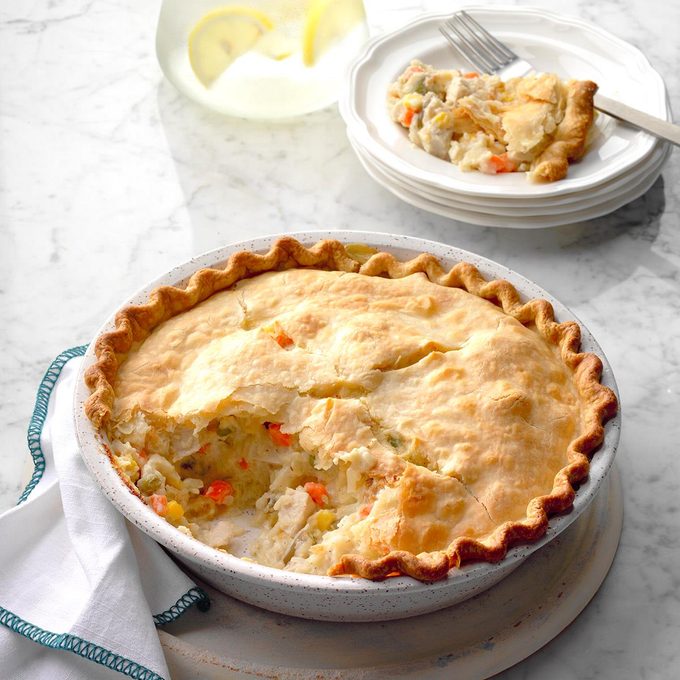
Gilt Craven Potpie
The gold crust and flossy sauce make this veggie-packed pie a surefire hit. Mild and comforting, the family favorite has convenient freezer instructions for a night when in that location'southward no time for prep. —Taste of Dwelling house Test Kitchen
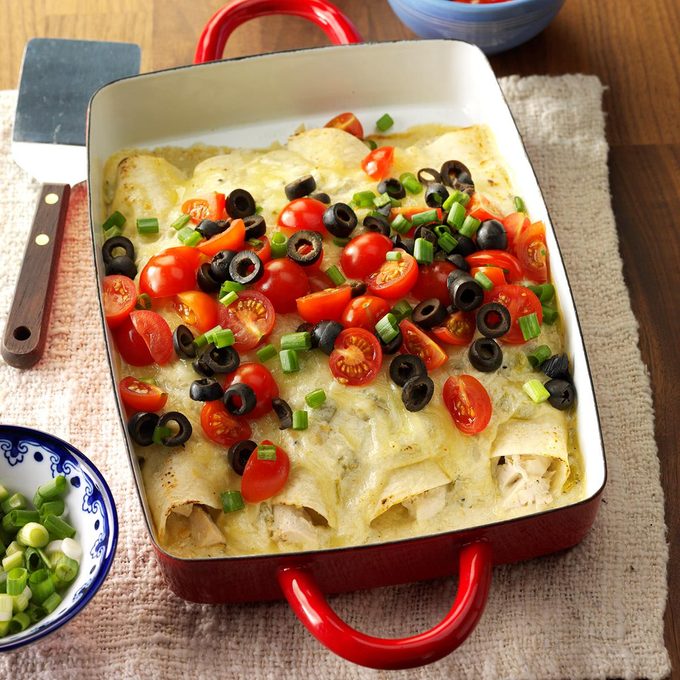
Chili Chicken Enchiladas
This repast's a great way to apply upwards leftover cooked chicken, and a wonderful pick-me-up to take to friends who need a little assist. —Alicia Johnson, Hillsboro, Oregon
Champion Chicken Puffs
My guests peeled safety getting to the tabular array to munch on my chicken puffs. The tender bites are fabricated with hassle-complimentary refrigerated crescent rolls and a flavorful craven and cream cheese filling. —Amber Kimmich, Powhatan, Virginia

Contest-Winning Greek Pasta Broil
I've taken this hot dish to potlucks and it's received rave reviews. There'due south never a morsel left. All-time of all, it'due south a simple, good for you and hearty supper made with ingredients that are like shooting fish in a barrel to find. —Anne Taglienti, Kennett Square, Pennsylvania

Chicken and Dumplings
Perfect for dank winter nights, this main course is speedy, low in fat and a delicious one-dish meal. —Nancy Tuck, Elk Falls, Kansas
Chicken-Stuffed Cubanelle Peppers
Hither'southward a different accept on traditional stuffed peppers. I substituted craven for the beef and used Cubanelle peppers in place of the green peppers that are normally featured in such a dish. —Ron Burlingame, Canton, Ohio
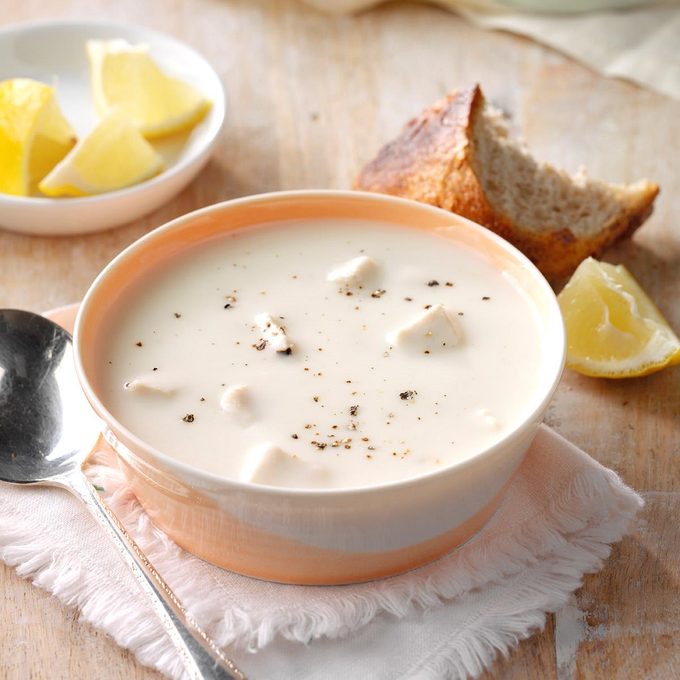
Lemony Craven Soup
While living in California, I enjoyed a delicious chicken-lemon soup at a local restaurant. When I returned to Texas, I experimented with many versions before landing on this ane. —Brenda Tollett, San Antonio, Texas
Orangish Chicken Spinach Salad
For a salad with refreshing color and crunch, we toss chicken and spinach with mandarin oranges and red onion, and so splash everything with a tangy vinaigrette. —Jean Murawski, Grosse Pointe Park, Michigan

Slow-Cooked Sauerkraut Soup
Nosotros alive in Lancaster County, which has a rich heritage of German language culture. Our dishes often include sauerkraut, potatoes and sausage. We bask this recipe on cold wintertime evenings, forth with muffins and fruit. —Linda Lohr, Lititz, Pennsylvania
Zippy Chicken Enchiladas
Leftover chicken gets an awesome makeover in this rich and creamy casserole. This colorful dish is loaded with flavor. It's a overnice alter of footstep from beef enchiladas. —Julie Moutray, Wichita, Kansas
Mom's Paella
I savour cooking ethnic foods, peculiarly those that call for lots of rice. Like my mom, I often prepare this dish for special Dominicus get-togethers. Traditional paella uses saffron, but turmeric is a upkeep-friendly alternative. —Ena Quiggle, Goodhue, Minnesota
Broccoli & Chicken Cheese Strata
On our dairy farm, chores often delay dinner. That's when this strata comes in handy. I'll gear up it beforehand and later pop it in the oven for a quick and like shooting fish in a barrel meal. —Margery Moore, Richfield Springs, New York
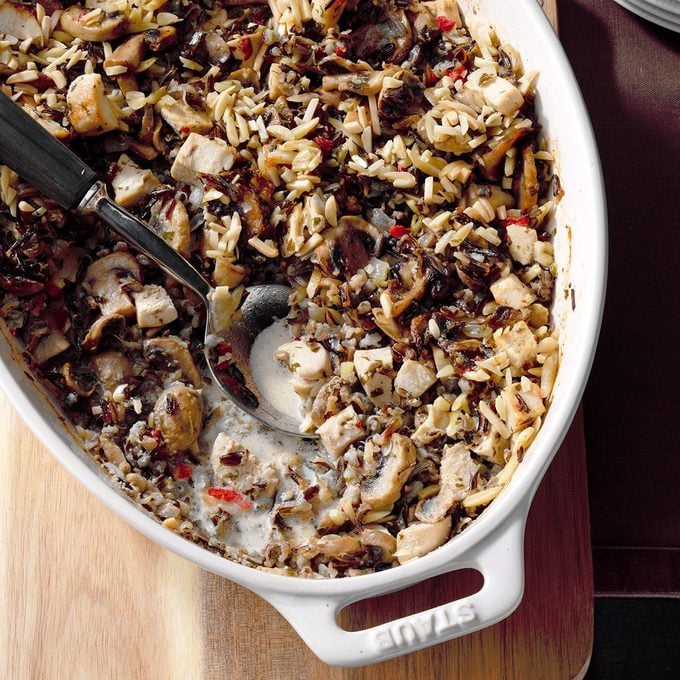
Chicken and Wild Rice Broil
This recipe is a great example of Midwest food! Its ingredients, including the wild rice, tin can all be establish in Minnesota. The dish is good for larger groups since the cook doesn't need to spend a lot of fourth dimension in the kitchen. —Suzanne Greenslit, Merrifield, Minnesota
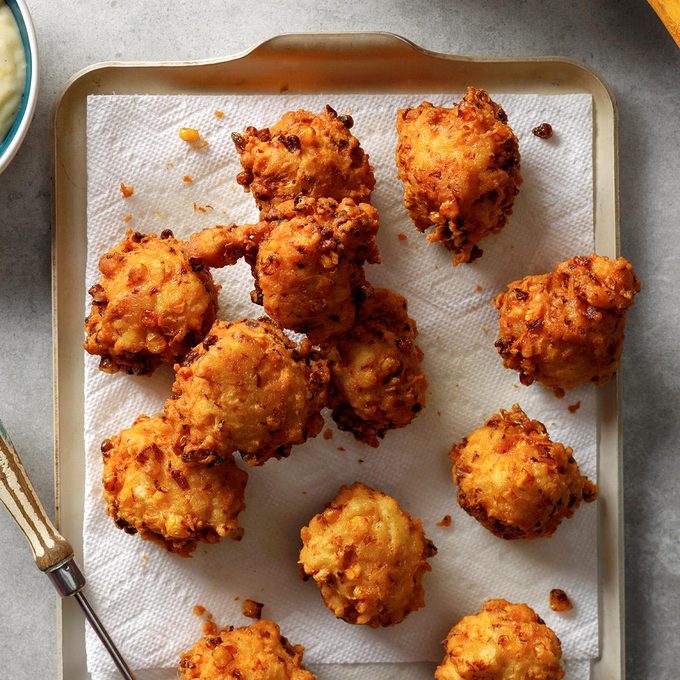
Chicken Corn Fritters
I've always loved corn fritters, simply they weren't satisfying as a principal dish. I came up with this recipe and was thrilled when my husband and our three immature boys gave information technology rave reviews. The chicken and zesty sauce make these a wonderful brunch or dejeuner entree. -Marie Greene, Scottsbluff, Nebraska
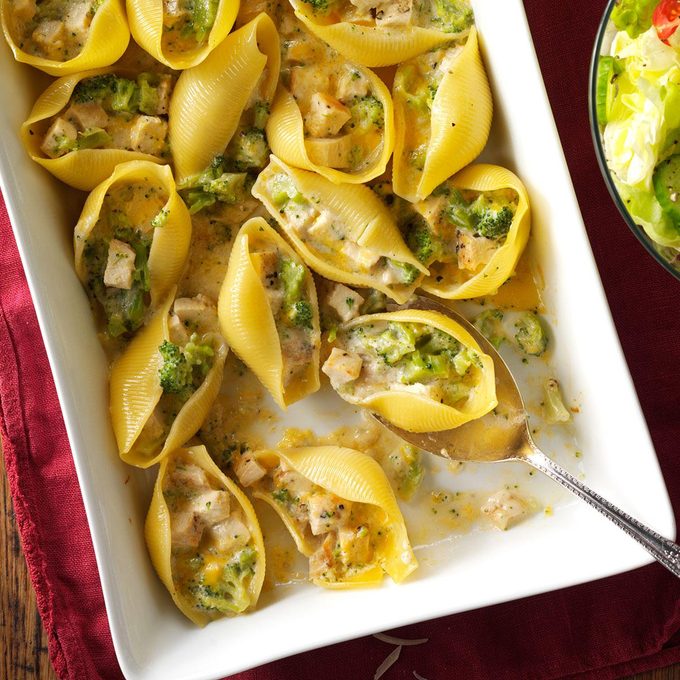
Chicken Broccoli Shells
This cheesy entree is a make-alee dream. Just assemble information technology ahead of time and put information technology in the oven when company arrives. I round out the meal with a tossed salad and warm bread. —Karen Jagger, Columbia Metropolis, Indiana
BBQ Chicken Sandwiches
With four small children at dwelling, I demand quick yet filling meals. This family-favorite BBQ chicken sandwich filling is a cinch to make. For a spicier taste, eliminate the ketchup and increase the corporeality of salsa to one cup. —Leticia Lewis, Kennewick, Washington
Craven Noodle Casserole
Everyone who tries this comforting, cheesy chicken and noodle casserole asks for the recipe. It's then simple to brand that sometimes I feel like I'grand cheating! —Kay Pederson, Yellville, Arkansas
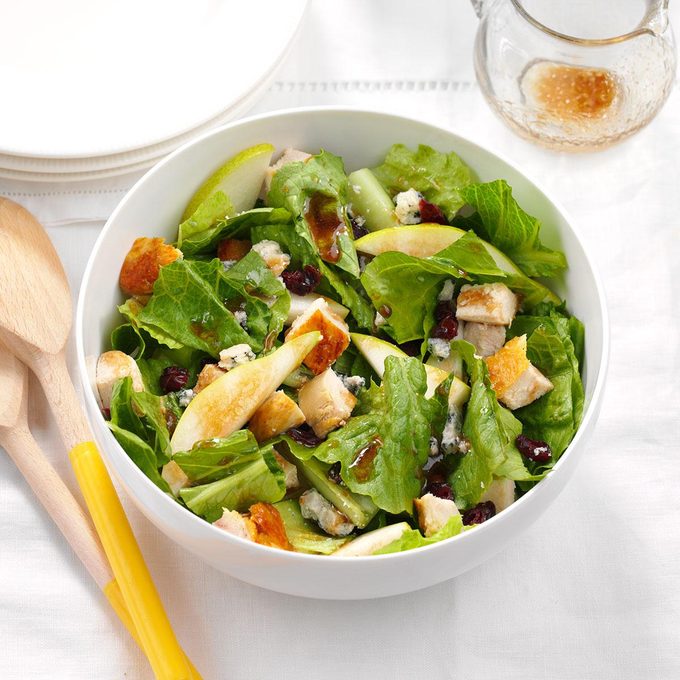
Pear Chicken Salad with Maple Vinaigrette
Classic pear salad gets an innovative makeover with chicken and maple vinaigrette. We like to serve it over crisp romaine for a refreshing experience. —Chrysa Duran, Cambridge, Minnesota
Chicken Enchiladas with Cream of Chicken Soup
A must for whatever Mexican meal at my house, attempt these enchiladas as a primary dish or include them as part of a cafe. —Cheryl Pomrenke, Coffeyville, Kansas
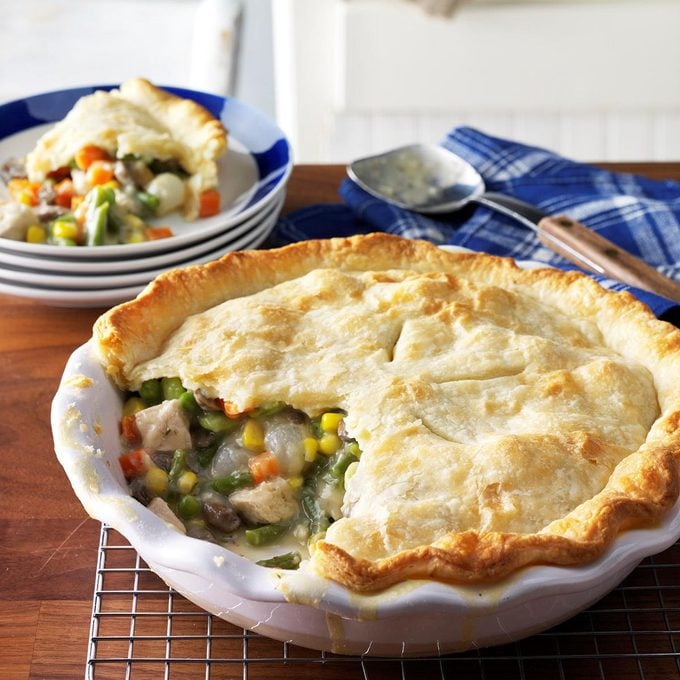
Classic Chicken Potpie
Our neighbors and a friend from back abode are always afterward me to make "those yummy potpies". That's all the encouragement I need, since we really similar 'em, too! —Ada May Smith, Citrus Springs, Florida.
Chicken and Chiles Goulash
This casserole makes skilful use of leftover meat and is very filling. —Lois Keel, Alburquerque, New United mexican states

Turkey a La Male monarch
This is a smart way to use up leftover turkey. You lot might desire to make a double batch! —Mary Gaylord, Balsam Lake, Wisconsin
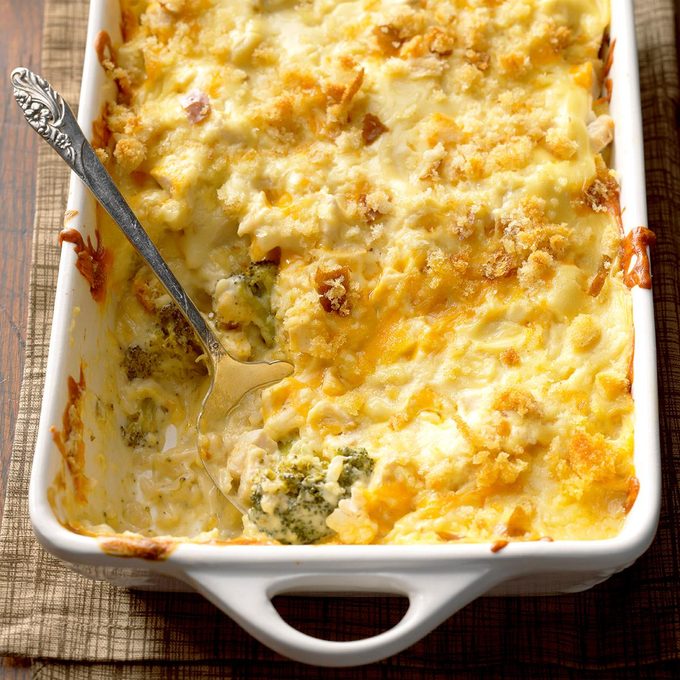
Chicken Divan
This tasty craven divan recipe was given to me by a friend years ago, and it's been a family favorite e'er since. My daughters enjoy making this dish in their ain homes and go the same enthusiastic compliments I e'er do! —Mary Pat Lucia, Northward East, Pennsylvania

Comforting Chicken Noodle Soup
A expert friend made u.s.a. this rich, comforting, creamy chicken noodle soup after the birth of our son. It was such a assistance to have dinner taken care of until I was back on my feet. This yummy dish is and so simple to prepare that now I give a pot of it (along with the recipe) to other new mothers. —Joanna Sargent, Sandy, Utah

Chicken Tortilla Broil
Mother oftentimes fabricated this comforting chicken tortilla goulash when I was growing upwardly. Our family unit would scrape the pan clean. Chicken, cheese and zippy light-green chiles are a mouthwatering mix.—Jerri Moror, Rio Rancho, New Mexico

Craven Biscuit Potpie
This hearty chicken potpie recipe with biscuits takes just x minutes to assemble before y'all can pop it in the oven. —Dorothy Smith, El Dorado, Arkansas

Chicken Brunch Bake
Chunks of tender chicken add heartiness to this appealing brunch casserole. This was my son'southward favorite hot lunch meal from loftier school. —DeLee Jochum, Dubuque, Iowa

Ham 'n' Swiss Chicken
This saucy casserole allows you lot to enjoy all the rich, traditional flavour of Cordon Bleu with less attempt. It's a snap to layer the ingredients and let them melt all afternoon. Just toss a salad to make this meal complete. —Dorothy Witmer Ephrata, Pennsylvania

Crescent Chicken Bundles
When I was expecting our third child, this was ane of the meals I put in the freezer ahead of fourth dimension. We now have four kids and they all like these rich craven pockets. You tin substitute ham or turkey for the chicken. —Jo Groth, Plainfield, Iowa
Turkey Puff Pancake
Your family or guests are sure to say 'Wow!' when you nowadays them with this dish that rises then high and browns so beautifully. I sometimes add together water chestnuts for crunch. —Patricia Millmann, Wauwatosa, Wisconsin
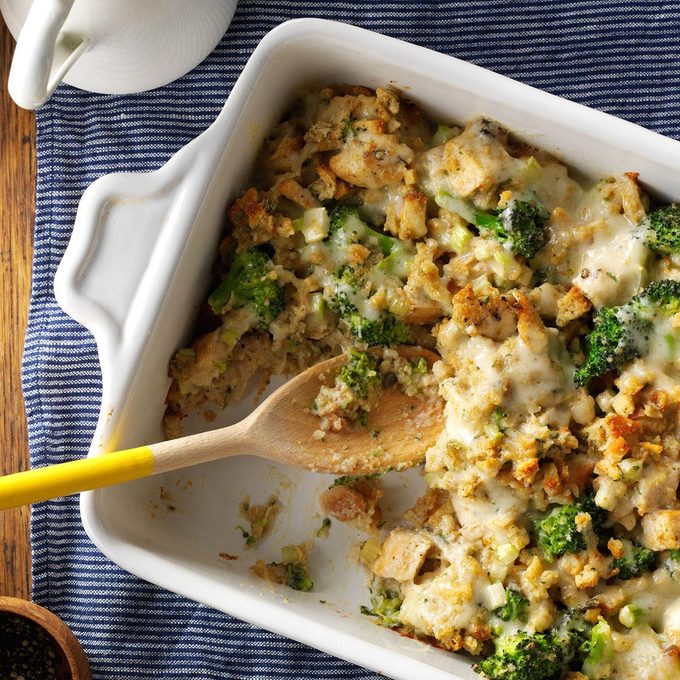
Chicken and Swiss Stuffing Broil
I dear to cook only just don't take much time. This casserole is both comforting and fast, which makes it my favorite kind of recipe. I serve it with a green salad. —Jena Coffey, Dusk Hills, Missouri
Craven Burritos
This mouthwatering chicken burrito recipe makes enough for two casseroles, so you lot can savour one today and freeze the other for a busy weeknight. They're super to take on hand for quick meals or to have to potlucks. —Sonya Nightingale, Burley, Idaho.
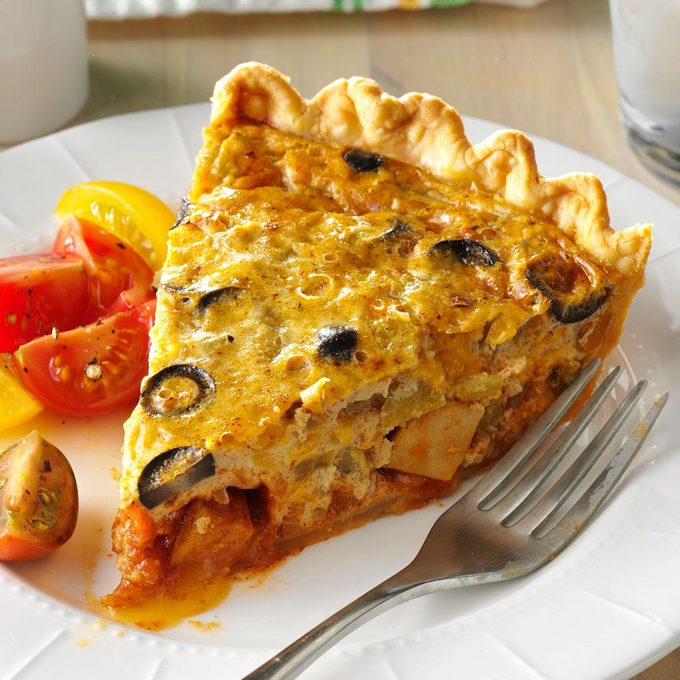
Craven Taco Quiche
I wanted to make a quiche but didn't want the usual flavors, so I used ingredients I had in my pantry and refrigerator to come up with this recipe. I was surprised at the cracking gustatory modality and how well the flavors came together. My neighbor asked for the recipe and had the same success! —Tamie Bradford, Grand Forks AFB, Due north Dakota
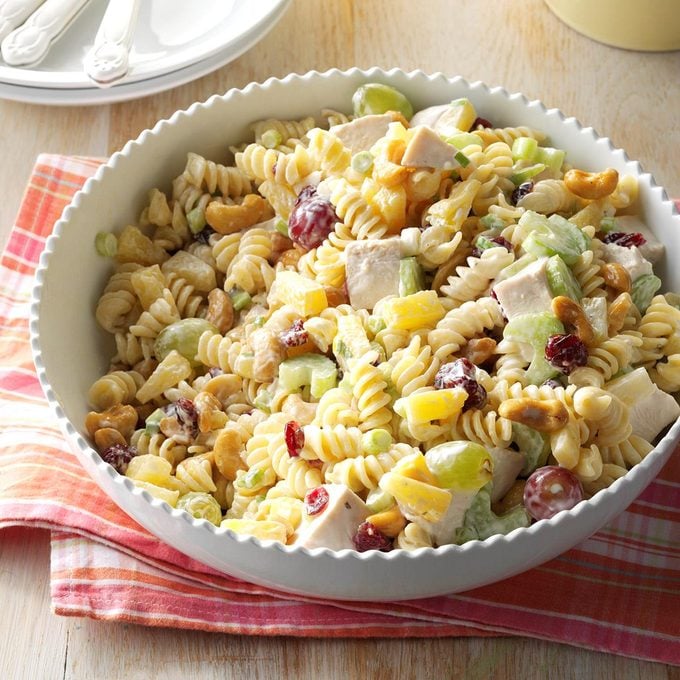
Cashew-Craven Rotini Salad
I've tried many chicken salad recipes over the years, but this is my very favorite. It's fresh, fruity and refreshing, and the cashews add wonderful crunch. Every time I serve it at a potluck or picnic, I get rave reviews—and ( always come dwelling with an empty bowl! —Kara Cook, Elk Ridge, Utah
Craven Zucchini Casserole
A co-worker shared this chicken zucchini goulash recipe that was originally her grandmother'southward. When I make it, I use pre-cooked chicken from the grocery shop and fresh zucchini my neighbour gives me from his garden. —Bev Dutro, Dayton, Ohio
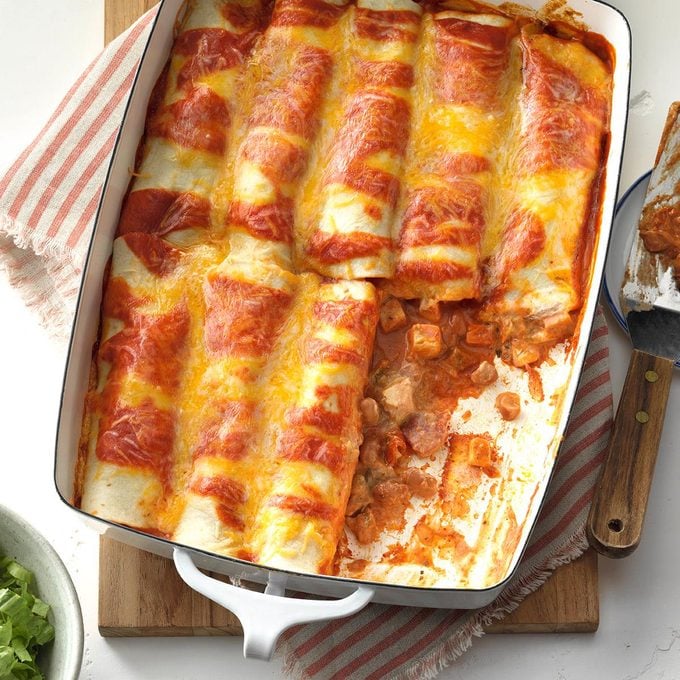
Piece of cake Chicken Enchiladas
This chicken enchiladas recipe is so quick and easy, and I ever receive a ton of compliments. It apace becomes a favorite of friends whenever I share the recipe. Modify the spiciness with the intensity of the salsa and the green chiles to adapt your sense of taste. —Kristi Black, Harrison Township, Michigan

Curried Chicken Corn Chowder
This recipe is close to 1 my mom used to make for u.s. kids when the weather turned cold. Hers called for heavy cream, but I came up with a slimmer version that I think is pretty true to the original! —Kendra Doss, Colorado Springs, Colorado

Cornbread Stuffing
At least ten of us women made this quondam-fashioned dressing to feed over 1,500 people at our church'south fall festival. Everyone thought it was wonderful. It'south the best dressing I've ever fabricated. —Patty Kierce, Weir, Texas

Easy Cheddar Chicken Potpie
My kids love chicken potpie, and I really similar that this is so quick and easy to put together with frozen veggies and store-bought gravy. To go far even simpler, my friend and I decided to top information technology with a beige crust instead of homemade pastry. Information technology'south delicious! —Linda Drees, Palestine, Texas
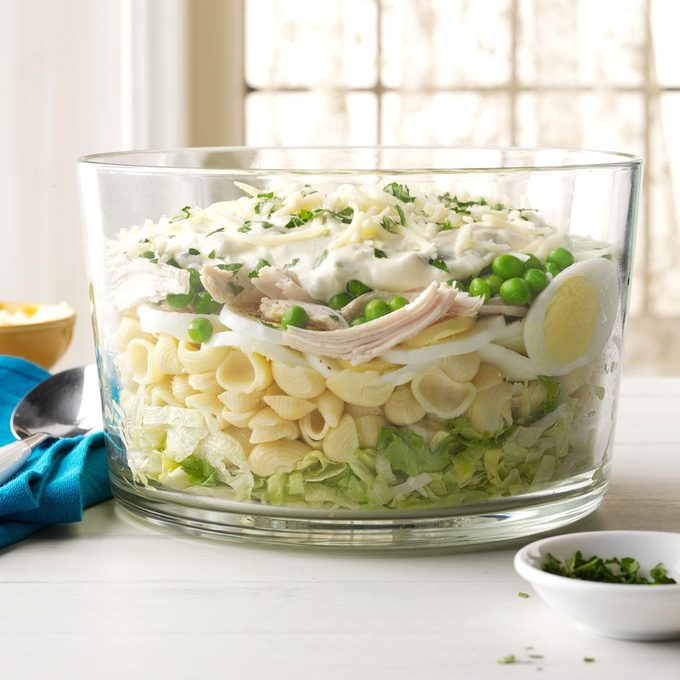
Brand-Alee Hearty Six-Layer Salad
This salad is an all-time favorite. I attain for the recipe whenever I need a dish to pass. Information technology is piece of cake to brand, tin can be assembled ahead of time and looks marvelous. —Noreen Meyer, Madison, Wisconsin
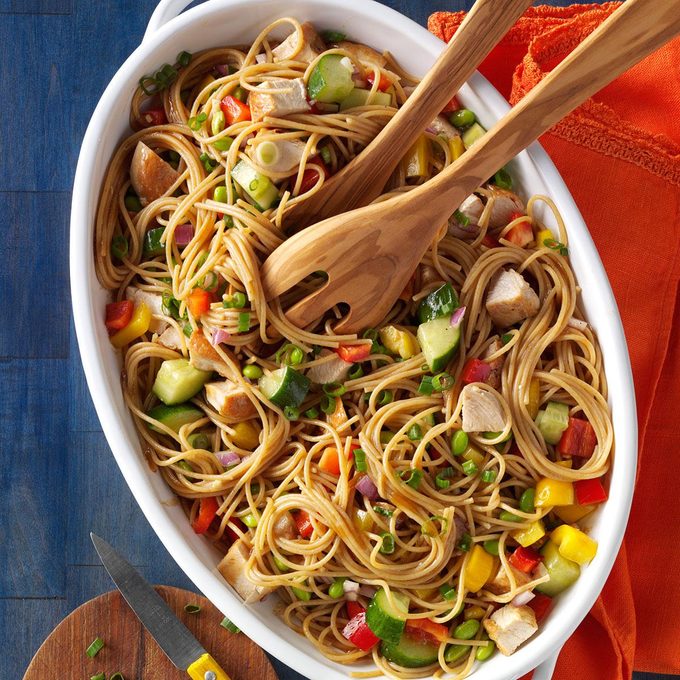
Gingered Spaghetti Salad
We honey this chilled craven salad brimming with colorful veggies. Make it meatless by omitting the chicken and tossing in more edamame. —Cindy Heinbaugh, Aurora, Colorado

Creamy Dull-Cooker White Chicken Chili
My friend Caroline Gray and I came up with this creamy slow-cooker white chicken chili. It'due south unusual because it calls for Alfredo sauce. —Cindi Mitchell, St. Marys, Kansas
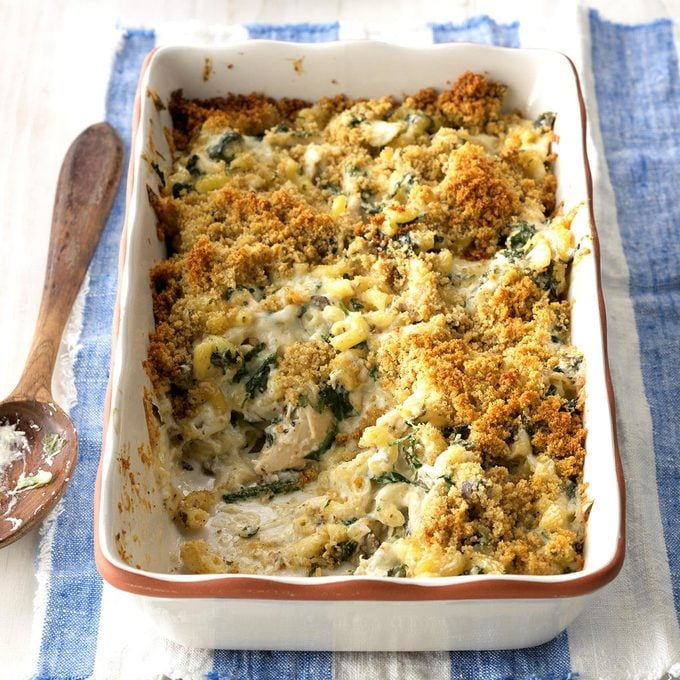
Chicken Florentine Casserole
Flossy and comforting, this chicken and spinach bake is certain to be a hit at dinnertime. The toasty staff of life crumb topping delivers a bit of a crunch. —Dori Jackson, Gulf Breeze, Florida
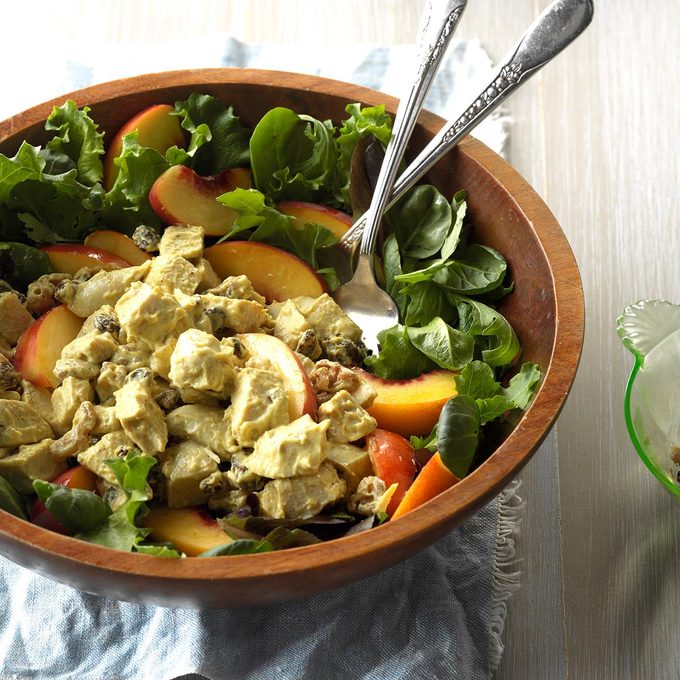
Curried Craven & Peach Salad
This is a very healthy and uncomplicated salad to make; fifty-fifty my non-cooking husband can whip information technology together in minutes. We've served this to friends over the years, and they always ask for the recipe. —Radelle Knappenberger, Oviedo, Florida
Craven & Cheese Noodle Bake
This is the recipe my daughters and I frequently brand for new parents when they come home from the hospital. With its flossy spaghetti filling and melted cheese topping, this casserole holds a nice cut and comforts hungry tummies. —Fancheon Resler, Bluffton, Indiana
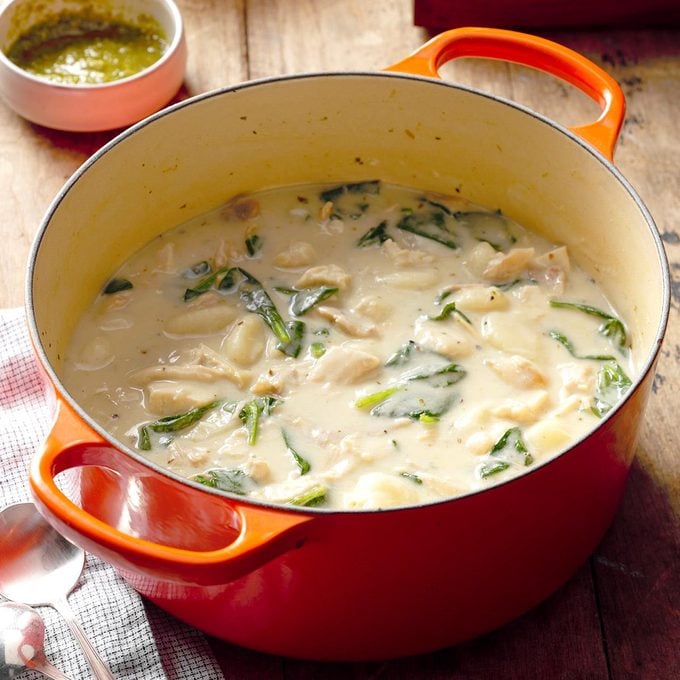
Chicken Gnocchi Pesto Soup
Later tasting a similar soup at a restaurant, I created this quick and tasty version. The pesto adds an extra-nice Italian flavor that is oftentimes missing from other gnocchi soups. —Deanna Smith, Des Moines, Iowa t

Chicken Salad Party Sandwiches
My famous chicken salad arrives at the party chilled in a plastic container. When information technology's fourth dimension to set out the nutrient, I stir in the pecans and get together the sandwiches. They're a hitting at buffet-fashion potlucks. —Trisha Kruse, Eagle, Idaho

Risotto with Craven and Mushrooms
Portobello mushrooms add an earthy flavour to this creamy archetype, while shredded rotisserie chicken makes information technology a snap to prepare. You'll savor every seize with teeth. —Charlene Chambers, Ormond Beach, Florida

Holiday Chicken & Sausage Wreath
Hearty enough to cutting into larger slices equally a chief dish, this golden wreath brims with a delicious, ooey-gooey meat filling. Y'all'll desire to make this ane year-round! —Jane Whittaker, Pensacola, Florida
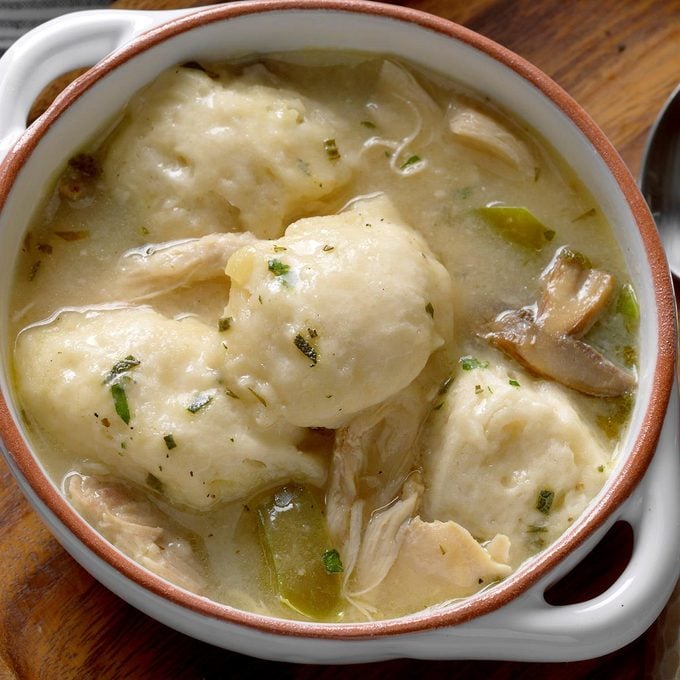
Quick Craven and Dumplings
Using precooked chicken and set up-fabricated biscuits, this hearty dish is comfort nutrient made simple. Information technology's the perfect way to warm upwardly on chilly nights. —Lakeya Astwood, Schenectady, New York
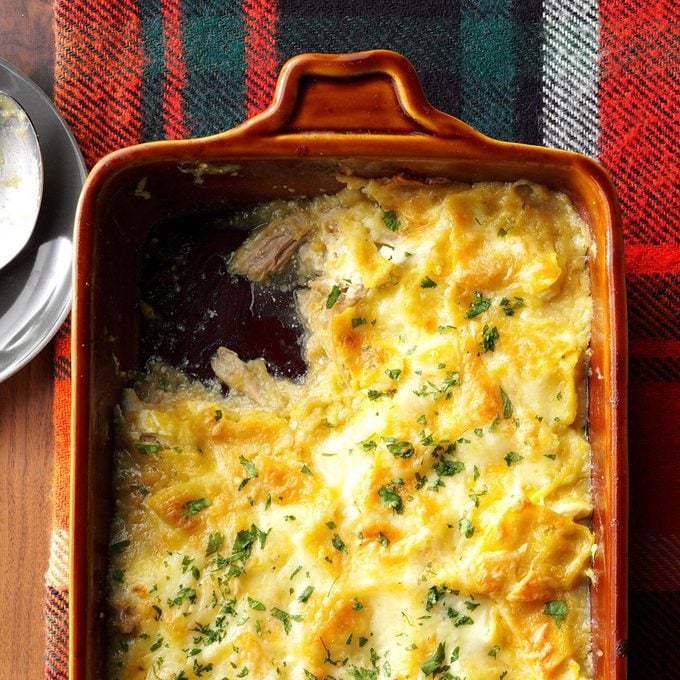
Chicken Enchilada Bake
Your family is going to gobble up this cheesy, southwestern and like shooting fish in a barrel chicken enchilada casserole…and will enquire for it again and once again. Information technology's real comfort food! —Melanie Burns, Pueblo Westward, Colorado
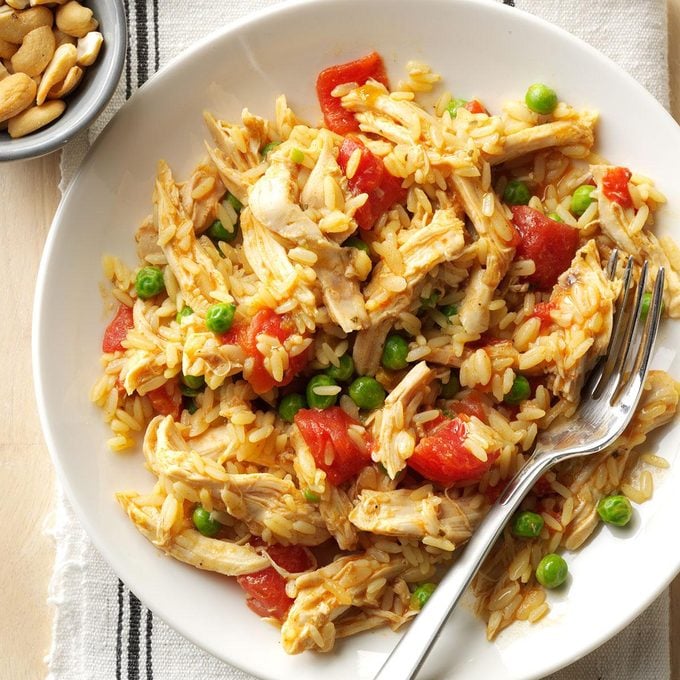
Curry Chicken and Rice
I updated this chicken and rice dish past adding veggies and cashews to give it fresh and crunchy entreatment. The green chilies in the tomatoes give it just the right little boot, but if you really like spice, add together fresh, diced jalapeño. —Denise Klibert, Shreveport, Louisiana
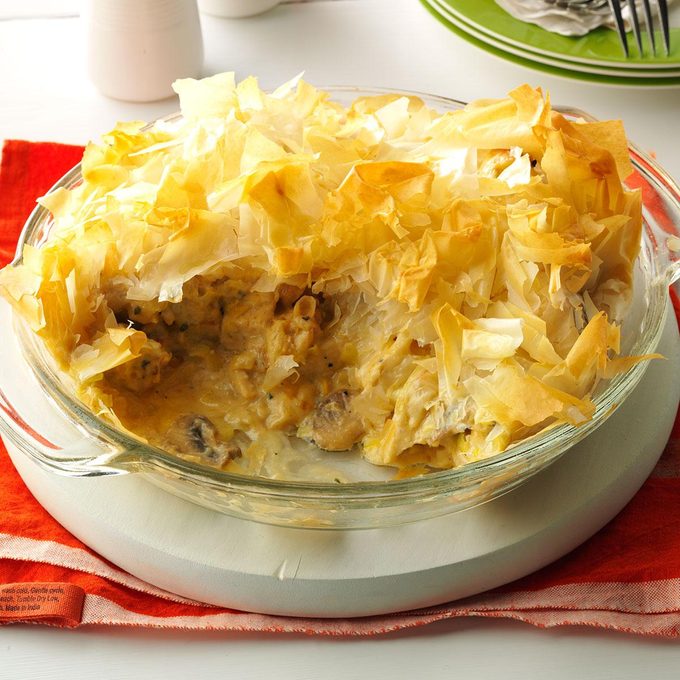
Cheesy Chicken and Leek Phyllo Pie
In our firm, chicken potpie is a year-round staple. For a springtime experience, we use leeks and mushrooms and a lighter phyllo dough crust. If you don't have gruyere, try Parmesan. —Andrea Stewart, Toronto, Ontario
Chicken, Asparagus & Corn Chowder
Craven and asparagus make a light, comforting soup that's easy to do with mutual ingredients. If nosotros take rotisserie craven, information technology goes into this soup. —Jennifer Vo, Irvine, California
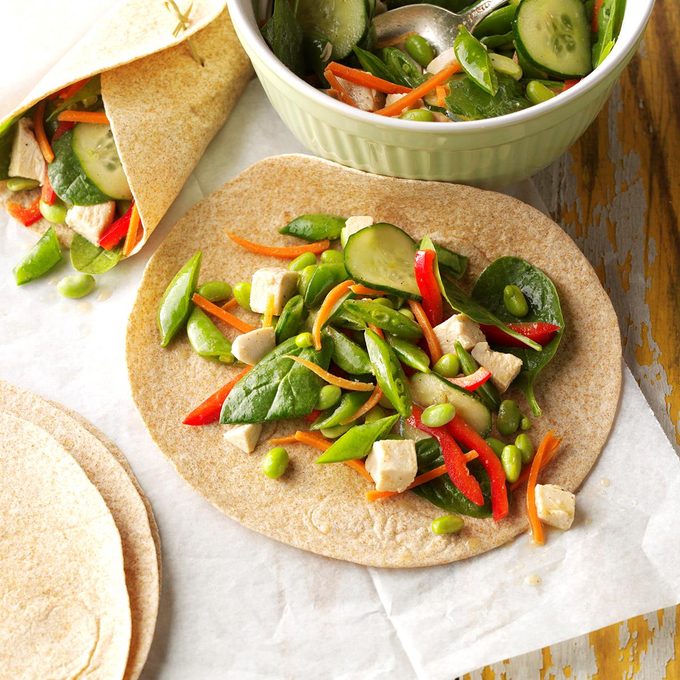
Sesame Chicken Veggie Wraps
I'g always on the lookout man for fast, nutritious recipes that will appeal to my three little kids. They happen to love edamame, so this is a smart choice for those on-the-become days. —Elisabeth Larsen, Pleasant Grove, Utah
Baked Pot Stickers with Dipping Sauce
Twisting these wonton wrappers like piffling candies makes them fuss-complimentary, and the dipping sauce is packed with sweetness heat. —Taylor Marsh, Algona, Iowa
Loaded Chicken & Gouda Calzones
When I had my girl, I tried to have a lot of meals in the freezer to make those starting time few weeks easier. These calzones were one of our favorites! We loved beingness able to pull them out and accept dinner in minutes. I've dipped these in spaghetti sauce, pesto and ranch dressing, and they were all delicious! —Elisabeth Larsen, Pleasant Grove, Utah
Garlicky Chicken Pizza
Tomatoes, olives and goat cheese really brighten upwardly this white pizza. I similar to cook extra chicken for this recipe while making another repast. Just make sure the tomatoes are well drained to go on the crust dainty and crispy. —Teri Otte, Cannon Falls, Minnesota

Uncomplicated Sesame Chicken with Couscous
I created this dish after my three kids tried Chinese takeout and asked for more. To make things easy for myself, I typically use a rotisserie chicken from the deli. —Naylet LaRochelle, Miami, Florida
Chicken Cordon Bleu Crescent Ring
A archetype cordon bleu has chicken, cheese and ham. To change it up, roll everything inside crescent dough for a hand-held meal. —Stella Culotta, Pasadena, Maryland
Source: https://www.tasteofhome.com/article/why-todays-saran-wrap-is-less-sticky/
0 Response to "Why Today's Saran Wrap Is Less Sticky"
Post a Comment